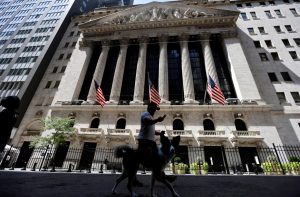Don’t get too attached to those recent stock market gains, at least according to strategists polled by Reuters.

FILE PHOTO: A man walks a dog in the shade away from the midday sun past the New York Stock Exchange (NYSE) building in Manhattan, during hot weather in New York City, New York, U.S., August 11, 2020.
SAN FRANCISCO: Don’t get too attached to those recent stock market gains, at least according to strategists polled by Reuters.
Wall Street’s rally is likely run out of fuel as investors fret about the November presidential election, with the major indexes ending 2020 below current record highs, according to the poll, conducted over the past two weeks.
The S&P 500 will end 2020 at 3,300 points, down over 4per cent from current levels, according to the median forecast of about 55 market strategists and fund managers.
That would leave the closely watched benchmark with an annual 2per cent gain in a year that saw the coronavirus cripple the global economy and leave tens of millions of Americans out of work.
While strategists are generally unsuccessful at predicting stock market performance, their forecasts provide a valuable snapshot of expectations across Wall Street.
Uncertainty about the outcome of the Nov. 3 presidential vote and how it affects markets is becoming a major concern for investors.
For weeks ahead of the 2016 election, strategists warned that instability caused by a potential Donald Trump victory would hurt Wall Street, only to see markets rally after he won.
With President Trump repeatedly claiming, without evidence, that plans to allow mail-in ballots would lead to a surge in electoral fraud, some investment strategists warn that uncertainty about the integrity of the vote and its outcome could roil financial markets.
So could a potential knockout blow by Democrats, giving the party control of Congress as well as the executive branch, which could lead to higher taxes and tighter regulation, some respondents said.
“The market is not pricing in the potential for a Democrat sweep in November, which would create massive headwinds for the economy and the markets,” said Synovus Trust portfolio manager Daniel Morgan.
The S&P 500 last week returned to record highs for the first time since February, wiping out all of the deep losses caused by the coronavirus pandemic. The index’s new highs confirm, according to a widely accepted definition, that the S&P 500 entered a new bull market after tumbling to a low on March 23.
Behind the S&P 500’s over 50per cent recovery have been bets on a potential coronavirus vaccine, trillions of dollars in fiscal and monetary stimulus, and a surprisingly high percentage of companies that beat earnings expectations in the second quarter.
Still, many investors worry about the disconnect between the stock market and the U.S. economy, which remains crippled by high unemployment and a resurgence in virus cases in parts of the United States.
Forecasts from IBES data from Refinitiv show analysts expect a 20per cent decline in earnings for S&P 500 companies for 2020, with the second quarter still seen as the low point for this year. Earnings are expected to increase 28per cent in 2021, according to Refinitiv.
The poll also showed strategists expect the Dow Jones Industrial average to finish 2020 at around 28,330, which would represent an increase of less than 1per cent from Tuesday. Up 55per cent from its March bottom, the Dow is still down nearly 5per cent from its February record high.
The median prediction for the S&P 500’s closing level in 2021 was 3,500, equivalent to a near 2per cent increase from Tuesday’s level.

